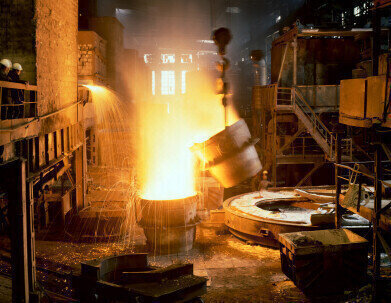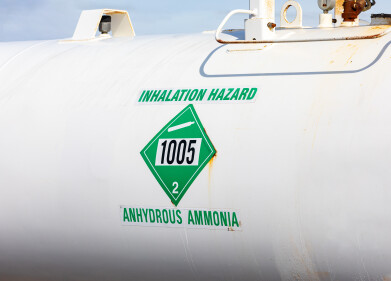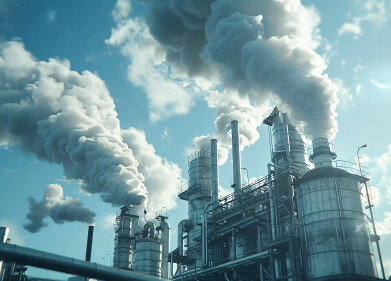Fuel for Thought
How can we decarbonise steel production?
Jan 12 2024
Historically, early industrial manufacturers were attracted to coal, oil and natural gas on account of their uniquely high energy-density. It took only a very small, easy-to-transport volume of fossil fuel to produce decent amounts of heat, a tempting proposition if you’re in charge of industrial processes that require high temperatures, as many do. Today, across the European Union, around a quarter of industrial processes require temperatures in excess of 400°C. So, for most of our industrial history, if you’re melting silica, calcinating limestone, smelting iron or aluminium, or firing an industrial kiln, you used coal, oil or natural gas.
But sooner or later, we’ll have to close this chapter. Industrial emissions account for almost 25% of global GHG emissions, with much of this contribution supplied by smelting in the iron and steel industries (7%) as well as getting those high temperatures for reactions in the chemical sector (4%). Yet, since fossil fuels tend to outstrip the energy-density of most industrial batteries and alternative fuels, these processes have proven particularly tricky to decarbonise. In essence, what’s needed is a shift in the technology at the heart of our industrial societies, almost a fresh Industrial Revolution.
What will it take, then, to start again?
Electric arc furnaces
Rather than combustion, electric arc furnaces (EAFs) use conduction. Inside the furnace, electricity passes through graphite or carbon electrodes into whatever metal is to be melted, releasing intense heat as the current arcs over the small gaps between the two materials. Such a process can generate temperatures of around 3,000°C. In 2022, more than 70 percent of steel made in the U.S. was produced via EAF technology, according to Recycling Today. Although green direct-reduced iron (DRI), which removes oxygen from iron ore by combusting it with hydrogen to form water vapour, and other scrap alternatives have made inroads, scrap remains the predominant feedstock in the sector.
Recognizing the potential of EAFs, governments across the EU and beyond are investing heavily in this technology. For instance, British Steel's transition from basic oxygen furnaces (BOF) to EAFs is underpinned by a £300 million grant from the British government, a move aimed at job retention and environmental sustainability. Companies like H2 Green Steel in Sweden and Blastr Green Steel in Norway are also receiving support from the EU, marking a significant shift in the industry.
The expansion of EAF projects in Europe is a testament to the commitment to decarbonize steel production. National governments and the EU are backing numerous projects, often integrating them with existing BOF facilities but replacing coal with hydrogen or other raw materials. Major steel producers, including ArcelorMittal and Liberty Steel Group, are actively investing in EAF or coal-free converter capacities, signalling a paradigm shift in steelmaking.
With the increasing adoption of EAF technology, the demand for steel scrap and hydrogen is expected to surge. This trend indicates that even steel producers focusing on DRI production will inevitably become part of a larger, global scrap market. The EU, traditionally an exporter of steel scrap, is projected to transform into an importer as more steelmakers switch to EAFs.
In a groundbreaking initiative, Iberdrola and H2 Green Steel have signed a billion-euro deal to build a 1,000 MW green hydrogen plant. This plant aims to fuel a direct steel ore reduction furnace capable of producing 2 million tonnes of pig iron annually, drastically reducing CO2 emissions by 95%. Set to commence production between 2025 and 2026, this project exemplifies the industry's commitment to decarbonization.
Bioenergy
ArcelorMittal, the world’s largest steel firm in terms of size and second largest producer of steel, operates plants in Brazil, France, Mexico, Algeria and South Africa, among many other countries – and it’s taking a different approach. Whilst gradually replacing coal with biomass, ArcelorMittal aims to capture by-products CO and CO2 for bioethanol, itself a (semi-)renewable fuel and feedstock for other industrial processes.
This venture into bioethanol production marks a significant shift from traditional steelmaking processes. In a typical blast furnace, coal is used to chemically reduce iron ore into iron, which is then processed into steel. This method releases substantial amounts of greenhouse gases, notably carbon monoxide (CO) and carbon dioxide (CO2). Traditionally, European steelmakers have captured these by-product gases to transform them into electricity and heat. However, the CO2 was inevitably released into the atmosphere, contributing to the industry’s substantial carbon footprint.
Addressing this issue, ArcelorMittal Belgium is implementing a groundbreaking technology – a first of its kind in terms of scale and complexity – known as the Carbalyst® project. Developed in partnership with US firm LanzaTech, this technology captures the CO- and CO2-rich off-gases from the blast furnace and transforms them into ethanol through a gas fermentation process. This process utilizes microbes to convert the captured gases into bioethanol, which can be sold as a fuel or feedstock for various chemical processes.
ArcelorMittal is not stopping at bioethanol production. In its quest for a greener footprint, the company is also focusing on the Torero project, which aims to partially replace fossil coal with bio-coal in the blast furnace. Bio-coal is derived from waste wood treated through torrefaction, a process that makes it a viable substitute for fossil coal. This innovative approach presents a dual advantage: it utilizes waste material while reducing dependency on fossil fuels.
The first commercial production of ethanol at ArcelorMittal’s Steelanol plant in Ghent, Belgium, is a landmark achievement. This plant, Europe’s first carbon capture and utilization (CCU) project, has an annual capacity to produce 80 million litres of ethanol. Its operation is expected to reduce the Ghent plant's carbon emissions by 125 thousand tons per year. The resulting ethanol has diverse applications, ranging from transportation fuels to paints and perfumes, bolstering efforts to decarbonize the chemical sector.
The commercial installation of the Steelanol plant was funded through various sources, including the Flemish government, the Belgian federal government, the EU’s Horizon 2020 research and innovation program, and a loan from the European Investment Bank. Such financial backing is pivotal for the success of these green initiatives.
ArcelorMittal’s pioneering work in biofuel and biochar is setting new standards in the steel industry. By closing the carbon circle through the Carbalyst® and Torero projects, the company is not only advancing in its own sustainability goals but also paving the way for other steelmakers to follow suit. The transition from conventional blast furnace technology to greener alternatives is not just a necessity for environmental preservation but also an opportunity for industrial innovation and economic growth.
Nuclear co-generation
Advanced Modular Reactors (AMRs) offer a viable solution for generating temperatures well up to 2,000°C. This high-temperature heat is crucial for processes like thermal water splitting, which involves using heat to split water into hydrogen and oxygen. Such hydrogen can then be used in greener steelmaking methods, like direct reduced iron (DRI) technology, significantly reducing the carbon footprint of steel production.
SMRs, capable of producing 300MW of energy or less, present a flexible and scalable alternative to traditional large-scale nuclear plants. They can be strategically located near industrial clusters to meet specific energy demands. The next generation of these reactors, AMRs, are expected to generate even higher temperatures, essential for the most challenging decarbonization processes in industries like steelmaking.
The UK, guided by the Royal Society's report "Nuclear cogeneration: civil nuclear energy in a low-carbon future," is leading the way in exploring nuclear cogeneration's potential. This approach allows nuclear plants to adapt their output according to the energy demand, switching between electricity generation and other applications like hydrogen production or district heating. This flexibility is particularly beneficial in an energy landscape increasingly dominated by intermittent renewable sources like wind and solar.
For the steel industry, which accounts for a significant portion of global carbon emissions, nuclear cogeneration offers a path to drastic reductions. The high-temperature heat from AMRs could be employed in the steelmaking process, either directly or through the production of hydrogen for DRI technology. This approach could revolutionize steel production, making it cleaner and more sustainable.
While the technology holds great promise, its implementation faces several challenges. Key among these is public acceptance, especially concerning the proximity of nuclear reactors to urban areas for district heating purposes. Additionally, the ownership of reactors, the future demand for hydrogen and other cogeneration products, and the cost factors associated with carbon emissions and reliable power are crucial considerations.
If challenges are addressed and the potential of nuclear co-generation is fully harnessed, it could play a critical role in meeting the UK’s and the EU's carbon neutrality goals by 2050. With possible applications extending beyond steelmaking to include hydrogen production and direct air capture of carbon dioxide, nuclear cogeneration could be a cornerstone of a sustainable industrial future. The next few years are pivotal, with SMRs possibly joining the grid by 2028 and the feasibility of high-temperature AMRs demonstrated by 2035, marking significant milestones in green steel production.
Digital Edition
PIN 25.5 Oct/Nov 2024
November 2024
Analytical Instrumentation - Picturing Viscosity – How Can a Viscometer or a Rheometer Benefit You? - Sustainable Grease Formulations: Evaluating Key Performance Parameters and Testing Method...
View all digital editions
Events
Dec 03 2024 Dusseldorf, Germany
Dec 08 2024 Anaheim, CA, USA
Turkey & Black Sea Oil and Gas
Dec 11 2024 Istanbul, Turkey
Dec 19 2024 Aurangabad, India
Jan 20 2025 San Diego, CA, USA



















